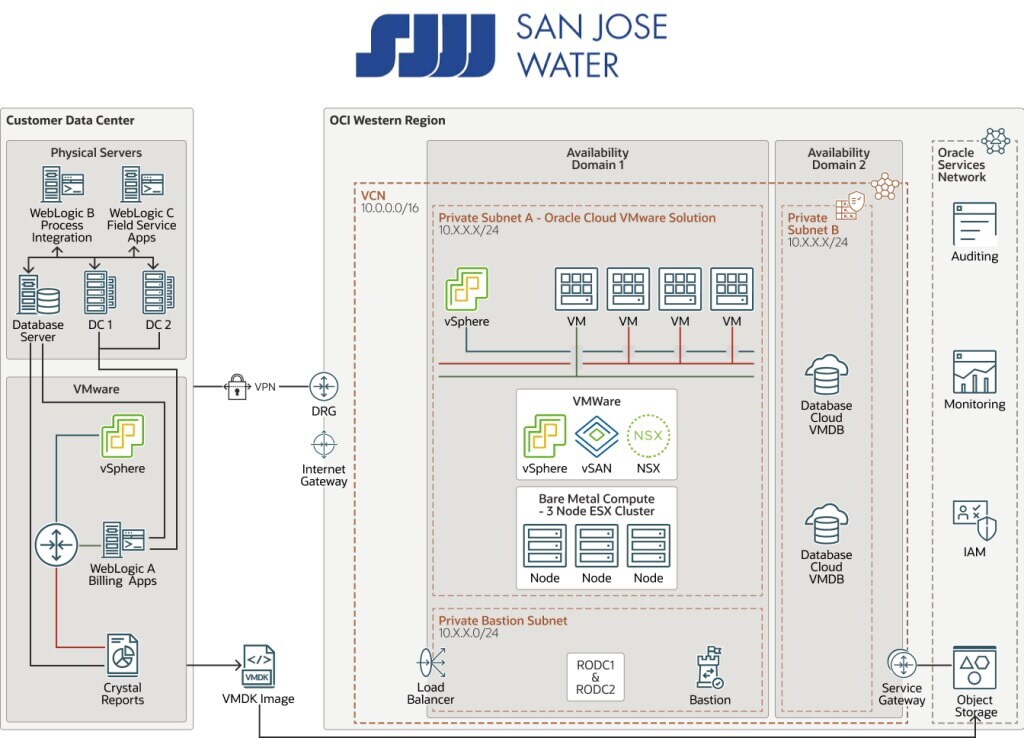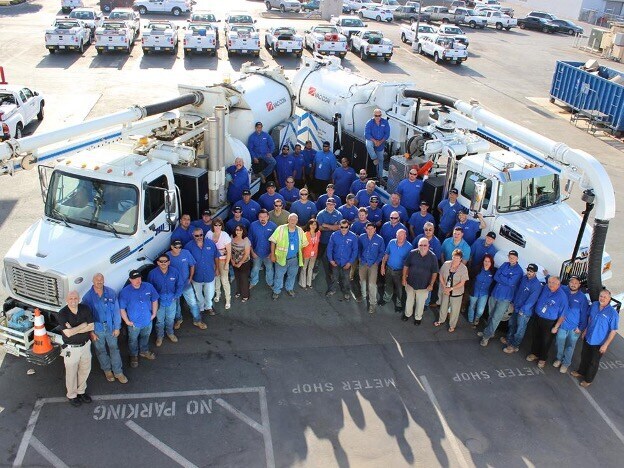San Jose Water improves application performance by 50–60% with Oracle Cloud VMware Solution
December 7, 2022 | 8 minute read
Written by Kellsey Ruppel, principal product marketing director at OCI, and Sheryl Sage, senior principal product manager at OCI Development Leadership. The authors want to thank Alexander Hawk, director of customer information systems at San Jose Water, for his contributions.

While 2020 was challenging with the onset of the COVID-19 pandemic, 2021 presented its own obstacles as the pandemic forced communities and utilities to navigate these new circumstances. Looking ahead, water utilities like San Jose Water (SJW) are seeking to overcome operational challenges by driving revenue, collecting additional data insights, and optimizing their operations. One of the top trends includes transitioning aging mechanical meters to electronic models and implementing flexible advanced metering infrastructure (AMI) systems to transform how customers and utilities monitor water usage. In fact, SJW recently received California Public Utilities Commission (CPUC) approval for smart meter technology.
Founded in 1866, San Jose Water is an investor-owned public utility and one of the largest and most technically sophisticated urban water systems in the United States. The company serves over one million people in the greater San Jose metropolitan area with high-quality, life-sustaining water. SJW services the operations and maintenance, billing, and backflow testing of utilities, and was looking for a way to move their virtual environment from numerous on-premises systems to the cloud.
Goals for cloud migration
Aging, costly, and hard-to-scale IT infrastructure stood in the way of SJW scaling their business. VMware workloads included legacy customer care billing applications, WebLogic, and Crystal Reports, which were all running on older Windows versions. SJW decided on a multicloud strategy that takes advantage of the unique capabilities of both Oracle Cloud Infrastructure (OCI) and Microsoft Azure.
“By migrating our legacy applications to OCI, SJW increased application performance more than 50%, simplified administration, and improved system availability,” said Alexander Hawk, director of customer information systems at San Jose Water. “The application performance improvement was very well received by end users, developers, analysts, and administrators who now spend much less time waiting for processes to complete. The server administration was greatly simplified through virtualization on Oracle Cloud VMware Solution, and easy-to-use tools and services available in the Oracle Cloud Console. System availability was enhanced through the Oracle Cloud VMware Solution cluster; redundancy was already built into OCI. Oracle was there for us every step of the way, and always had a resource available when we ran into challenges. The Oracle Sales and Technology Teams really went above and beyond for us and made our migration to OCI a success.”
Suite of Oracle products used
OCI includes all the services needed to migrate, build, and run IT in the cloud, from existing enterprise workloads to new cloud native applications and data platforms. SJW used the following OCI services and technologies:
- Oracle Enterprise Database: Oracle Enterprise Database managed compute and storage infrastructure allow customers to efficiently run Oracle Database on virtual machines (VMs) in OCI Compute instances. Consumption-based subscription pricing for managed compute and storage infrastructure with low-cost OCI block storage enable IT departments to lower the cost of running Oracle Database workloads in the cloud.
- Oracle Cloud VMware Solution: Oracle Cloud VMware Solution is a full stack VMware software-defined data center (SDDC), designed to easily migrate VMware workloads to OCI on bare metal hosts. Customers can deploy and operate VMware environments in a securely isolated customer tenancy with predictable performance and costs. Customers manage cloud infrastructure and VMware consoles for complete administrative control.
- OCI Networking: Networking and connectivity products and services enable customers to manage and scale their networks. Customers can connect securely to a customizable, isolated virtual cloud network (VCN) and take advantage of inexpensive data egress charges. Granular access control of networking technologies provides connectivity solutions across both physical and virtual networks.
- Network security groups: Network security groups (NSGs) act as a virtual firewall for Compute instances and other kinds of resources. An NSG consists of a set of ingress and egress security rules that apply only to a set of VNICs choice in a single VCN. For example, all the Compute instances that act as web servers in the web tier of a multitier application in the VCN.
- Security lists: Security lists act as virtual firewalls for Compute instances and other kinds of resources. A security list consists of a set of ingress and egress security rules that apply to all the VNICs in any subnet that the security list is associated with. So, all the VNICs in a subnet are subject to the same set of security lists.
Third-party software used
- LogicMonitor: SJW uses LogicMonitor, the leading software-as-a-service (SaaS)-based unified observability and IT operations data collaboration platform for enterprise IT and managed service providers, used for monitoring and observability of OCI. LogicMonitor also helps identify resource and network connection.
- Rubrik: SJW is using Rubrik to backup application servers VMs in Oracle Cloud VMware Solution and database servers running on Oracle Compute instances.
Migration path and Oracle solution
In October 2020, SJW did a proof-of-concept (POC) with Oracle, which included a pilot, mock cutover, and production cutover. Networking and knowledge of application versions proved to be successful, with the SJW andOracle support also a win. SJW decided to move forward, taking on an initiative to move their virtual environment for the following systems from on-premises to OCI:
- Customer care and billing (WebLogic Java application server)
- Mobile work force management (WebLogic Java application server)
- Process integration pack for utilities field work (WebLogic Java application server)
- Business objects (SAP reporting server)
The following diagram illustrates San Jose Water’s reference architecture:

Running the Oracle Database, WebLogic, and applications on Oracle offered SJW improved performance and easiest migration path. SJW moved these existing workloads to OCI over the course of a weekend with minor modifications.
With Oracle Cloud VMWare Solution, SJW’s IT administrators can now manage software versions certified for production operations. IT decides when patches and upgrades are applied. IT staff has root access to the cloud infrastructure, allowing for fine-grain tuning of business application performance management. Oracle Cloud VMware Solution provides full Layer-2 network control. SJW was able to operate both on-premises and in the cloud during the migration.
SJW manages a great deal of customer data. The Oracle Cloud VMware Solution delivers completely isolated customer instances, meaning each customer has a unique hardware stack inaccessible to other customers. Customers receive their own set of encryption keys. Oracle can’t access any of the customer data after their instance is deployed. Because Oracle Cloud VMware Solution is delivered as a bare metal architecture and doesn’t require any application or network refactoring, SJW teams can transpose existing VMware security practices, policies, and procedures hardened over many years. Oracle Cloud VMware Solution also has FedRamp High ATO, DISA IL5, HIPAA and PCI-DSS attestations for customers with stringent certification requirements.
As part of their migration, SJW used the best of both OCI and Microsoft Azure. SJW is using Azure for user authentication (LDAP) when logging into OCI and deploying LDAP servers on OCI.
SJW was able to retain existing staff and utilize existing tools and processes. The process had a slight learning curve because they had to do things differently with OCI. But SJW was able to use their VMware knowledge for migrating VMs, such as using vMotion, VMDKs, and object storage.
SJW partnered with Oracle Cloud Lift services for the Oracle Cloud VMware Solution implementation.
Results achieved with OCI
Utilizing OCI, SJW was able to replace aging infrastructure and improve the following aspects of their system.
- License: SJW was able to utilize existing licenses for their move to OCI. For the application servers, SJW migrated VMware, Windows, and WebLogic licenses from on-premises servers to new VMs in Oracle Cloud VMware Solution. For the database servers, SJW migrated existing Oracle Database and Windows licenses from physical on-premises servers to new Oracle Compute instances.
- Migration: The application migration process was simplified by migrating as-is. Application servers were cloned from on-premises servers, requiring only small application configuration changes for new server names. The database servers were rebuilt with an Oracle-provided Windows image on OCI Compute instances. High-performance block storage was attached. The databases were migrated by transferring a full backup of all databases in advance of the cutover weekend. An incremental database backup was then migrated. After thoroughly preparing for the cutover weekend with extensive testing, and two mock cutovers, the SJW team was able to complete the cutover to OCI in less than 10 hours.
- Backup and restore and high availability: Before moving to OCI, the SJW servers were hosted on a mix of virtual and physical servers. As the legacy applications and associated operating systems aged, backup/restore administration of the physical servers became increasingly challenging. Since moving to OCI, all application servers are now virtualized and reside on the Oracle Cloud VMware Solution. The virtualization of SJW’s applications has greatly simplified backup and restore processes, and the three-node architecture of Oracle Cloud VMware Solution cluster has greatly increased the application availability. The database servers which are now hosted on OCI on Oracle Compute instances, have also benefited from simplified backup and restore tools provided with OCI.
- Performance: SJW has experiencing significant application performance improvements since moving to OCI.
- 55% reduction in time running nightly batch processes (210 minutes to 100 minutes)
- 85% reduction in time with integrations between CC&B and MWM application (60 seconds to 10 seconds)
- 50% reduction in report run time
- 50%+ reduction is time spent for developers and analysts waiting for SQL queries to complete

Conclusion
SJW knew that refreshing aging, costly, and hard to scale on-premises IT infrastructure stood in the way of scaling their business. Instead of performing a hardware refresh for legacy applications on-premises, SJW selected Oracle Cloud VMware Solution because it could operate as an extension of the company’s on-premises environment. It allowed the team to move legacy workloads faster, while enjoying the same ease of management, scalability, security, and full admin rights as on-premises.
Explore more OCI customer Technical Case Studies and try Oracle Cloud Free Tier.
Related stories and resources
San Jose Water moves to Oracle Cloud VMware Solution, lifts app performance 50%
Serving approximately one million residents in the greater San Jose area, the utility gains performance improvements while becoming future-ready.